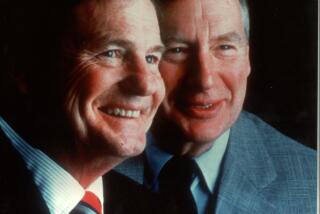Can PBS Survive Broadcasting’s New World Order? : Television: The public network is asking hard questions about its future at a conference this week. ‘We need to do something to adapt,’ says its acting president.
WASHINGTON — With corporate contributions dwindling and the prospect of 500 cable channels threatening to lure away viewers, public-television officials will gather Thursday to plan the most dramatic overhaul of the network in its quarter-century history.
The crisis facing public TV is reflected in the Draconian measures being explored to bolster its survival: Officials are considering options ranging from dismantling part of the 350-station public-television network to transforming the nonprofit Public Broadcasting Service into a high-tech marvel, able to distribute up to 60 channels of video via a new Telstar satellite to be launched this month.
The changes to be discussed at a two-day conference here could have wide impact on American society and the burgeoning telecommunications industry. With its extensive links to public-television stations run by universities, PBS has the potential to become a key element of the emerging information highway.
The Clinton Administration has been encouraging entrepreneurs to electronically link government, schools and industry so they can share data, video and other information. PBS TV licensees, many of whom also operate special low-power and closed-circuit TV stations, could be an important electronic conduit in the plan, officials say.
“What we are doing, basically, is reinventing public television,” said Robert Ottenhoff, acting president of the Public Broadcasting Service, which oversees the nationwide public-TV network. “It’s a watershed year for us in the sense that there’s a recognition that we need to do something to adapt.”
The soul-searching is occurring as the service, known for such staples as “Sesame Street” and “Great Performances,” is on the verge of choosing a new president. PBS, created in 1967 when President Lyndon Johnson formalized federal support for the nation’s confederation of educational and non-commercial broadcasters, is said to be interested in attracting a high-visibility candidate for the $143,000-a-year post.
Public television’s broadcast sibling, National Public Radio, recently signaled its aspirations by choosing one of the nation’s highest-ranking black telephone company executives, former Chesapeake & Potomac Telephone Co. President Delano E. Lewis, to head the radio network.
The new PBS president will face a tough challenge.
Like the three traditional commercial television networks--which faced a crisis in the 1980s when cable television, videocassette players and new competitors like the Fox network began siphoning away audience and advertising revenues--public TV is grappling with its future. To survive, it must devise a strategy for an era in which a tough economy has curtailed corporate giving and in which television is being transformed by its marriage with the computer, facsimile machine and telephone.
“The nature of television is about to change to a new stage; we’ve gone from a world dominated by network television to a multichannel world,” said Charles R. Firestone, director of the Aspen Institute, a Washington think tank. Soon, he added, it will enter a world of total video immersion, complete with interactive video games and comprehensive home shopping services.
Once-generous corporate giants such as International Business Machines Corp. and Eastman Kodak Co. have scaled back their contributions. Overall corporate support for public-television stations declined 13.4% to $77.5 million in the fiscal year that ended June 30, 1993. To meet the funding crunch, some public-TV officials, noting that communities such as the metropolitan Washington area have as many as four public-TV outlets, want to scale back the number of public stations to 200 from the present 350.
PBS’ programming niche is also under siege as the expansion of cable and other video providers encroach on its traditional highbrow franchise.
Prime-time viewership declined 12% from the 1987-88 season to the 1992-93 season, according to the A.C. Nielsen ratings service. A number of PBS shows, such as the home improvement program “Hometime,” have migrated to cable channels.
Viewer defections could grow worse as entrepreneurs assemble entire cable networks with an eye toward attracting more PBS viewers.
Last week, for example, the Cable News Network’s founding president, Reese Schonfeld, formally launched the Television Food Network on cable. He said that a study of potential viewers showed high viewership for PBS’ seven cooking shows. And in the works for next year are a book channel, two history channels and a jazz channel.
To combat encroachment, PBS hopes to strengthen its video franchise by bolstering educational TV offerings, and to reap additional financial benefits by selling spinoff books and interactive computer discs.
Already, a number of PBS shows are available on videotape. Public-TV stations in Nebraska offer programming that enables public-school students to learn Japanese. The South Carolina Public Television Network is providing a variety of programming to train auto workers for the state’s new BMW assembly plant, said Robert T. Coonrod, executive vice president of the Corporation for Public Broadcasting. The nonprofit agency provides funding for public radio and television broadcasting.
“I don’t think our problem is that we are too highbrow,” said Coonrod, when asked to analyze the challenge posed by cable and other entertainment technology. “There’s a lot of good stuff we offer if we could just make it more accessible. But I do think we could be more provocative.”
Despite the hand-wringing, public broadcasting has proved remarkably resilient since the first non-commercial TV station went on the air in Houston in 1953.
Honing its reputation as a purveyor of educational programs and high-culture shows featuring performances of opera and discussions of philosophy, public TV has survived political pressure from Capitol Hill over more controversial fare such as the “P.O.V.” episode “Tongues Untied,” which explored the lives of gay men.
Commercial networks have the financial wherewithal and, following a recent court approval, the freedom to directly invest and negotiate for financial stakes in the shows that they air. Public television, in contrast, has far more limited financial and technical options for fending off cable and other new technologies.
“We can’t take the risks that the commercial networks can,” said David Brugger, president of the Assn. of America’s Public TV Stations, whose board will attend this week’s conference along with those of PBS and the Corporation for Public Broadcasting.
“It’s more difficult for us because we don’t have the investment capital--we live from dollar to dollar.”
More to Read
The biggest entertainment stories
Get our big stories about Hollywood, film, television, music, arts, culture and more right in your inbox as soon as they publish.
You may occasionally receive promotional content from the Los Angeles Times.










